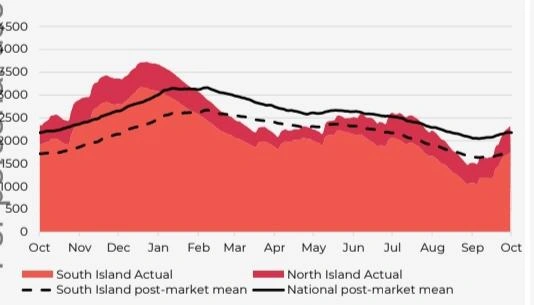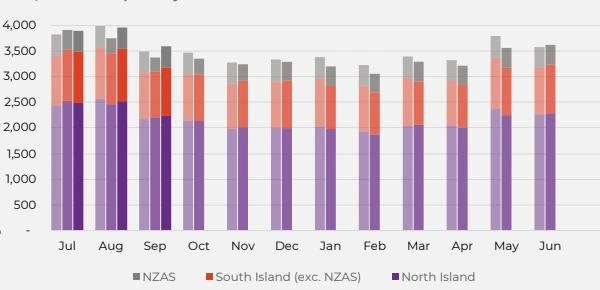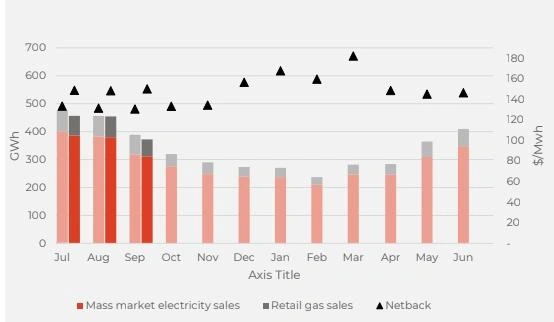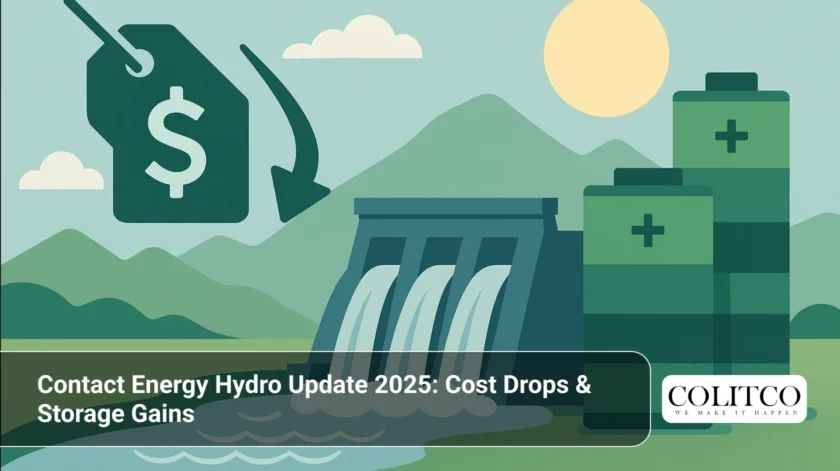The latest market report from Contact Energy highlights strong hydroelectric production for the fourth quarter of 2025, major increases in New Zealand’s water storage, and significant reductions in hydro generation costs.
The Contact Energy hydro update 2025 confirmed that the water supply in the South Island’s controlled storage was at 116% of the historical average, and in the North Island’s controlled storage, it was at 120% of the average. The Clutha hydro scheme, one of the company’s largest assets, also reported the same storage level as 120% of the mean.
Inflows through the Clutha basin during September 2025 were exceptionally high, at 143% of the mean, which ensured good reservoir levels before the summer.
Hydro storage in New Zealand numbers indicate a secure generation outlook for 2025, with reduced risk from dry years. Combined with recent hydro generation cost reduction, these metrics signal a resilient energy sector.
 New Zealand controlled hydro storage against mean/12 months
New Zealand controlled hydro storage against mean/12 months
What Are The Key Cost Reductions In Generation?
The Contact Energy hydro update 2025 has mentioned a remarkable decrease in generation costs. The total unit generation cost, which also included purchased generation, has gone down to $35.77 per MWh, which is significantly lower than the previous year’s cost of $52.04 per MWh.
On the other hand, the cost of own generation has also gone down to $25.70 per MWh, which is lower than the $31.40 per MWh it was in September 2024. This decline in hydro generation cost reduction is a clear indication of the efficiency of Contact’s plants, which benefited from good rains and lower purchase prices.
This kind of efficiency not only improves Contact’s retail margins but also allows the company to compete effectively in the increasingly crowded hydro storage New Zealand electricity market.
How Is Electricity Demand Trending In 2025?
Electricity use in New Zealand is expected to increase at a steady rate. According to the Contact Energy hydro update 2025, the national electricity demand went up by 6.5% compared to September 2024 and was 2.9% higher than September 2023.
Sales of the company’s mass-market electricity and gas reached 372 GWh, which is a little less than 389 GWh for September 2024. Nevertheless, wholesale contracted electricity sales were 736 GWh, which is lower than the prior year when it was 814 GWh, indicative of seasonal fluctuations and contract revisions.
The use of these data points out a change in the energy consumption pattern since the residential and business demands have stabilised after the volatility period over the recent years.
 Total Electricity demand FY24, 25 and 26 respectively
Total Electricity demand FY24, 25 and 26 respectively
What Market Prices Are Shaping Energy Outlooks?
In the past few months, considerable changes in electricity prices for the future have been observed. As of October 13, 2025, the Otahuhu futures wholesale price for the first quarter of 2026 was $170.10 per MWh, whereas it was $172 per MWh at the end of the quarter.
One month earlier, the futures price was $194.50 per MWh. These numbers suggest a slight softening trend but still high price pressure, which is partly due to market expectations regarding the constraints on thermal generation and supply of fuel.
As for Contact Energy, these market signals will play a crucial role in the planning of its generation mix and the future investment strategy related to hydro storage in New Zealand and further hydro generation cost reduction.
Contact Energy’s Broader Operational Focus
Company Contact Energy is still relying on hydro more than ever but has been diversifying its generation portfolio with development projects in solar, geothermal, and battery storage. The present projects are mainly the Glenbrook-Ohurua Battery Energy Storage System (BESS), Kowhai Park Solar Project, and Te Mihi Stage 2 geothermal expansion.
In the past month, the firm, along with its partners, produced or bought 820 GWh of electric power, which is less than the previous year’s 859 GWh. The customer business of Contact had a netback of $150.12 per MWh, which is an increase from last year’s $130.58 per MWh. This is due to the efficient operation of the company, the good pricing policy for the customers, and the hydro performance, which is strong, and thus the returns are sustainable.
The Contact Energy hydro update 2025 also indicates that such efficiency has boosted resilience within hydro storage in New Zealand, while supporting long-term hydro generation cost reduction targets.
 Retail Sales Volume and Netback (FY25 & 26)
Retail Sales Volume and Netback (FY25 & 26)
What Does This Mean For New Zealand’s Energy Market?
The Contact Energy hydro update 2025 sends out a welcoming sign to the power sector of New Zealand. High storage levels point to enough water reserves for the summer, while the expected support from the falling generation costs to the wholesale price cuts is the other factor in the power market.
The market will not lose sight of the weather variability and dry-year risks, but the current data gives the picture of a very resilient system. As Contact Energy continues to invest in the renewable and storage areas, its strategy is going to help New Zealand move towards cleaner and more flexible power generation.
Hydropower, supported by hydro storage in New Zealand, has a major role to play in that vision; it will be the renewable backbone as well as the balancing resource for the wind and solar that do not cause power fluctuations.
FAQs
Q1. What Is The Purpose Of Hydro Storage In New Zealand?
Hydro storage is a necessary step that Contact Energy and similar companies take to handle the water coming in and to supply electricity that is reliable and constant throughout the year.
Q2. Why Did Contact Energy’s Generation Cost Decline In 2025?
The hydroelectric plants favoured inflows, efficient operation of the plants, and lower acquisition costs, all of which contributed to the significant reduction of the cost of hydroelectric generation.
Q3. How Do Futures Prices Affect Contact Energy’s Operations?
The prices of futures contracts have an impact on the company’s operations through their influence on the planning process for the future, the scheduling of generation, and the decision-making regarding the choice of investing in thermal or renewable capacity.
Q4. What Role Does Hydro Play In The Country’s Renewable Transition?
Hydro is the mainstay of New Zealand’s renewables, providing the country with storage, flexibility, and grid-stabilising energy.












